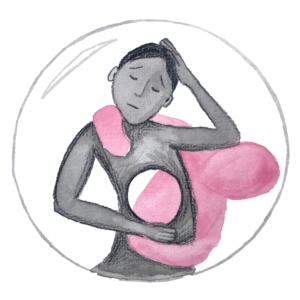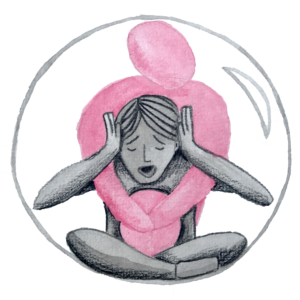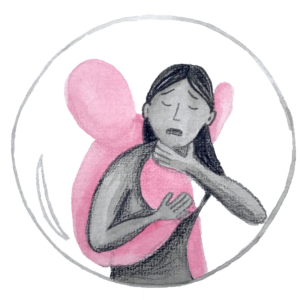
01 May Alumni Artist Showcase: Where is Grief Held?
Danielle Mitchell is an Summer Conference alumna (2014) and is married to Internship alumnus Joseph Mitchell. She works as a creative art therapist, a teacher, and an illustrator and she lives with Joseph in Titirangi, Auckland.
To illustrate lament I painted a triptych – three humans experiencing the felt sense of grief in different parts of their bodies. The slang term “gutted” aptly describes the physicality of loss for me. I feel oddly heavy and empty at the same time. In each illustration, three people hold grief as an empty space inside their bodies. The emptiness is held and witnessed, rather than filled.
Grief is Held in Stories
COVID-19 and all its implications, no matter the angle we look at it, has caused grief of many varieties:
Precious lives ended; jobs lost; gatherings cancelled; routines thwarted; holidays waylaid; goodbyes stolen; hopes delayed.
We are doing our best to respond creatively to the circumstances, but the loss is real.
I have my own COVID-19 grief story. In the first week of the New Zealand lockdown my grandma’s heart failed. I hadn’t been there when she went. I hadn’t been able to hold her hand and say goodbye. Instead, I had to settle for a brief moment alone with her body, and a funeral by video.
I lament that there is now an empty space that was once filled by my grandma’s vivacity, love, and soft, humble presence. Grief is there in my stomach, tightening my chest and head.
Grief is Held in the Body
In a recent interview, psychiatrist Dr. Stephen Porges addresses a profound dilemma experienced in the COVID-19 pandemic. Humans need the physical comfort of another person on a biological level. The presence of a trusted person can regulate the nervous system and bring relief. Keeping a physical distance, however, is key to stopping the spread of disease. The irony is cruel.
In Creative Art Therapy there is a general belief that to establish a therapeutic relationship, the therapist is encouraged to take the role of “witness”, never assuming the role of “fixer”. The idea is that, in times of distress, compassionate presence is often more curative than direct intervention.
Creative Art Therapist Rosa Heney builds on this concept of presence with the concept “withness”. “Withness” is more than observing someone’s grief; it is being with them in it. Emotional availability can be as good as a hug.
Grief is Held in the Biblical Story
One instance in the biblical narrative of grief, lament, and “withness” is found in the Gospel of John. In chapter 11, when Jesus is confronted with the death of Lazarus, rather than immediately seeking to fix things, we see unexpected grief. In verse 35, Jesus weeps.
At this time of relaxing lockdowns and collective eagerness to return quickly to normal and remedy the grief, lament offers us the chance to reflect on what we love and what has been lost. We can create spaces through our “withness” and prayer. We can hold each other, and be held by the God who weeps.
(Images copyrighted to Danielle Mitchell)




